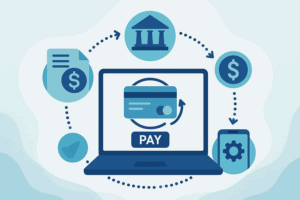The Ethereum blockchain continues to be a pillar of innovation, driving new business models and digital transformations for companies across the globe. However, while Ethereum’s programmability, decentralized security, and thriving ecosystem are tall advantages, large-scale enterprise adoption has been hampered by network congestion, high gas fees, and scalability bottlenecks. In response, Layer-2 scaling solutions have emerged as an essential piece of the puzzle, making Ethereum a realistic and appealing platform for enterprise-grade applications. Companies also realize that the Ethereum price is more than an investment metric—it’s a key factor influencing network dynamics, budgeting, and strategic IT decisions.
The Challenge: Scaling Ethereum for Enterprise Workloads
Ethereum’s core proposition—trustless, decentralized state and programmable smart contracts—created a global movement in fintech, supply chain, DeFi, and tokenization. Yet, as usage soared, its original “Layer 1” capacity (about 15–30 transactions per second) quickly became a bottleneck. During periods of high demand, transaction queues swell, confirmation times increase, and gas fees skyrocket. These issues are magnified when the Ethereum price surges, as gas fees (denominated in ETH) become more expensive in fiat terms.
For enterprises considering mission-critical deployments on Ethereum, these obstacles are not theoretical—they translate to unpredictable costs, poor user experience, and system unreliability. No chief technology officer can base a large-scale product on a network that grinds to a halt or costs $100 per transaction. To realize Ethereum’s potential in the enterprise sphere, robust, scalable, and cost-effective transaction processing is non-negotiable.
What are Layer-2 Scaling Solutions?
Layer-2 solutions are protocols built atop Ethereum’s main chain (“Layer 1”) that process, batch, or offload transactions off-chain, only periodically settling or updating state on the root Ethereum blockchain. The idea is to retain Ethereum’s security and decentralization, but achieve much higher throughput and far lower transaction costs—essential for business adoption.
There are several main types of Layer-2 solutions:
- Rollups (Optimistic and ZK): Bundle or aggregate hundreds of transactions into one. Optimistic rollups (e.g., Optimism, Arbitrum) assume transactions are valid by default, with fraud proofs available. Zero-knowledge (ZK) rollups (e.g., zkSync, StarkNet) use cryptographic proofs that guarantee all batched transactions are correct.
- Sidechains: Separate blockchains that run in parallel to Ethereum (e.g., Polygon PoS). They maintain their own consensus mechanisms but periodically synchronize states or checkpoints with Ethereum Layer 1.
- State Channels: Private two-way channels between users or business parties. After opening a channel on Ethereum, all interactions occur off-chain, with only opening and closing states recorded on the blockchain.
- Plasma: Constructs child “chains” anchored to Ethereum, where most processing occurs off-chain, but certain roots or summaries are periodically committed to L1.
How Layer-2 Solutions Benefit Enterprise Use Cases
Enterprises engaging with blockchain require predictability, low operational costs, privacy controls, and the ability to handle large numbers of users and transactions. Layer-2 solutions directly address these needs:
- Massive Throughput: Rollups and sidechains can process thousands, or even tens of thousands, of transactions per second, making high-volume business processes like loyalty points, supply chain events, payments, or DeFi feasible at scale.
- Pennies per Transaction: Transaction costs drop from several dollars (or more) on Ethereum Layer 1 to pennies or fractions of a cent on Layer 2, even when the Ethereum price is high.
- Faster Settlements: Users and businesses benefit from near-instant confirmation times, rather than waiting minutes or hours.
- Business Confidentiality: State channels and some zk-rollup features can provide companies with greater transactional privacy compared to Layer 1’s public ledgers.
- Programmability Retained: Most Layer-2 protocols are fully EVM-compatible, allowing the same smart contracts and business logic to be ported or reused.
Ethereum Price and the Economics of Layer-2 Adoption
The Ethereum price is a double-edged sword for business users. When ETH appreciates, on-chain transaction fees quickly erode operational margins for enterprises transacting directly on Layer 1. Layer-2 solutions allow companies to decouple core business activity from the volatility of Ethereum price. Here’s how:

- Fee Savings: By bridging to Layer 2, even when Ethereum price increases and gas fees rise, businesses only need to pay for an occasional batch update. Most transactions occur off-chain at negligible cost.
- Budgeting Predictability: With ultra-low, predictable transaction costs, companies can confidently plan IT budgets, product pricing, and support models, regardless of whether Ethereum price is $1,000 or $5,000.
- Unlocking New Business Models: Micropayments, metered services, pay-per-use, and automated DeFi strategies—often impossible on Layer 1 due to ETH price volatility—become practical and scalable.
Enterprise Integration: Layer-2 in Practice
A number of Layer-2 solutions are now enterprise-ready and seeing real-world adoption:
- Polygon (PoS & zkEVM): Used by major brands for loyalty platforms, NFT marketplaces, and large-scale payments. Recent innovations on zkEVM (zk-rollup with EVM support) allow seamless migration of Ethereum smart contracts.
- Arbitrum & Optimism: Popular for DeFi projects and enterprise pilots due to their high throughput and low latency. Arbitrum One, for example, has become the backbone for several large fintech dApps.
- StarkNet & zkSync: Power next-generation fintech, gaming, and supply chain projects that require extreme efficiency and privacy, leveraging the power of zero-knowledge proofs.
- Immutable X: A Layer-2 specialized for NFT and gaming, allowing instant, zero-gas minting and trading at enterprise scale.
Case Study: Supply Chains and Transparency
Consider a global logistics company using Ethereum to track shipments, automate payments to vendors, and verify product provenance. On Layer 1, the cost of recording every transaction and sensor update would be prohibitive, especially as Ethereum price rises. By moving transactional logic and data onto a Layer-2 rollup, the company can securely batch thousands of updates at a fraction of the cost, paying a single Layer-1 fee only for the periodic state commitment. This makes blockchain-based transparency practical across complex, high-volume supply chains.
Risks, Security, and Compliance
For enterprise adoption, the integrity and security guarantees of Layer-2 solutions are paramount. Leading rollups and channels derive their security from Ethereum’s Layer 1, but sidechains may use separate validators, which can introduce new risks. Smart contracts must be audited, and businesses need clear workflows for onboarding, offboarding, dispute resolution, and compliance.
Data privacy regulations (GDPR, HIPAA, etc.) prompt enterprises to consider whether Layer-2 maintains sufficient control and data compartmentalization. Some Layer-2s, especially zk-rollups, provide tools for selective disclosure or encryption, making compliance easier.
The best practice: Start with limited-scope pilots, use proven Layer-2 providers, and maintain regular security reviews and compliance checks. Monitoring the Ethereum price should always be part of financial and IT strategy.
The Road Ahead: Evolving Standards and Business Models
The adoption of Layer-2 is not limited to current protocols; the Ethereum ecosystem is in continual flux, with research into further rollup designs, cross-chain bridges, and interoperability protocols. Technologies like EIP-4844 (proto-danksharding) promise to further improve rollup efficiency and lower costs—future-proofing enterprise investments.
As businesses move core processes on-chain—payroll, invoicing, compliance, supply chain events, DeFi—Layer-2 will move from being an “add-on” to an essential foundation for scalable digital operations. The necessity for managing exposure to the Ethereum price will persist, but the direct linkage between operational costs and market volatility is much attenuated.
Conclusion: Ethereum, Layer-2, and the Enterprise Future
Ethereum’s vision for a decentralized, programmable economy is finally aligning with the realities of enterprise-scale business. Layer-2 scaling is the catalyst, eliminating the bottlenecks that once stifled growth and discouraged large-scale integration. Today’s Layer-2 solutions offer speed, affordability, and flexibility, sweeping aside traditional blockchain barriers such as prohibitive costs and network congestion—especially during spikes in Ethereum price.
As the landscape continues to mature, companies that embrace Layer-2 scaling early will be best positioned to leverage Ethereum’s global network effects, creative business models, and security guarantees. Monitoring the Ethereum price, staying updated on Layer-2 innovations, and maintaining best practices in security and compliance will help enterprises shape a new digital future—one where blockchain isn’t just a buzzword but the foundation of scalable, trusted business.















